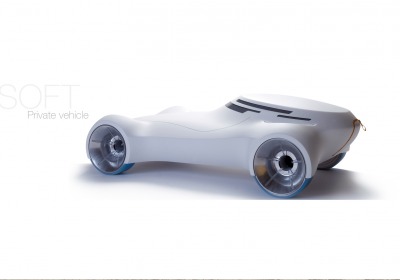Michelin Challenge Design 2009 preview
Wed, 07 Jan 2009 Michelin has released details of three more contenders which will be displayed at the Michelin Challenge Design exhibit at the 2009 NAIAS next week. The stand will feature 11 scale models and 24 two-dimensional drawings that were selected by a jury of top automotive designers. Among these are Raquel Aparicio’s Soft Vehicle, Fernando Gomez’s Packard concept and Niels Grubak Iversen and David Goncalves’ Phoenix concept.
We first saw Raquel Aparicio’s Soft Vehicle when we visited the Royal College of Art’s annual postgraduate degree show in June 2008. Created for a future in which GPS satellite systems will control private and public transportation, negating the need for passive crash protection, the automated vehicle is made from EVA foam – a recyclable material whose appearance is similar to neoprene or rubber and exists in lots of densities. Because of its properties, it is able to be vacuum formed, even permitting negative surfaces.
Aparacio’s first taste of automotive design was in Barcelona in 2002 when she embarked on the Vehicle Design course at Elisava. She was accepted into a one-year internship at Seat following her graduation in 2004 and began working at Fuore Design under the direction of Erwin Leo Himmel. In 2006, she moved to London to study vehicle design at the RCA. She is now working as an exterior designer at Kia Motors in Frankfurt.
While researching the history of American cars, Fernando Gomez discovered the key themes of tradition, innovation and quality, which led him to reference the Packard cars for his concept. In 1916, Packard introduced the first mass-produced V12 engine and produced airplane engines during WWII. Gomez’s concept proposes a modified version of this design with articulated connecting rods that allow his Super V12 to be arranged in three banks of four cylinders, thereby reducing the size of the block. A variable geometry suspension (VGS) is supplemented with rear transverse-transaxle gearbox for better mass distribution, thus improving stability.
Gomez, who lives in Uruguay, studied mechanical drawing and technology at the Uruguayan School of Technologic Studies and has worked as a drawer for many companies over the years. In 1983, he sent a design to Jaguar, and though they offered him congratulations and asked him to design a car based on the company’s KJ 12 and KJS models, his studies in Astronomy and Physics prevented him from continuing with the project. He is currently an Astronomy teacher, but his passion for car design has never waned. For him, cars are the perfect summary of technology and art.
Danish designer Niels Grubak Iversen and Portuguese product designer David Gonçalves both studied at Coventry University’s School of Art and Design in the UK and were awarded a Master of Science in Design and Transport with Distinction. Their Phoenix concept is a modern interpretation of the American way of life where freedom, strength, environmental awareness and flexibility are blended in a unique symbiosis between man and machine. Inspired by both American muscle cars and the US’s longstanding love affair with the pickup truck, the Phoenix is a two-seater car that is both agile and tough. A mid-ship engine placed right behind the cabin and four-wheel drive provides balance, grip and a low center of gravity.
With body panels made from easily recycled bio-composite materials and a substructure made from recycled aluminium, the Phoenix is also powered by a Flexi-Fuel V8 engine, which further boosts its environmental credentials without compromising performance. To enhance the safety of the occupants, the passenger compartment is enclosed by a safety cell made from reinforced bio-polymers.
Before completing his Masters degree, Iversen studied at Designskolen Kolding in Denmark and holds a Bachelors of Arts in Industrial Design. He is a two-time Michelin Challenge Design Finalist (2008 and 2009) and is pursuing a career as a car designer.
Gonçalves graduated in 2004 from the Faculty of Fine Arts in Lisbon with a BA in Product Design. While engaged in his course, he worked for an architecture studio in the city and collaborated in a series of projects with DASEIN. Later, in 2006, he developed a collection of lighting fixtures for a recently created brand (LumLighting) for Lustrarte, a factory in the middle of Portugal. He earned his Master’s degree in September 2008.
By

